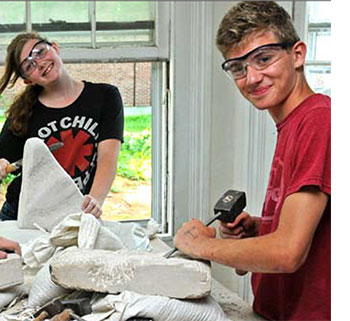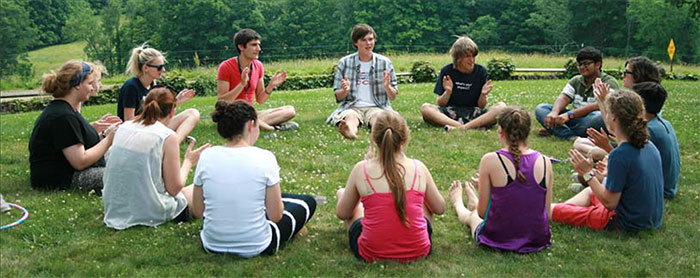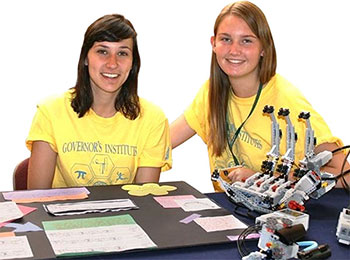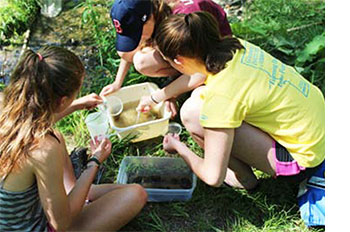| Governor’s Institutes of Vermont: Hands-on Learning for Youth with a Passion |
||
| by Elayne Clift | ||
Young Vermonters and students from other countries participate in a “Wisdom Circle” |
||
The outspoken voices of four young high-school women, who just participated in one of nine Governor’s Institutes of Vermont (GIV), best captures the spirit of GIV’s educational empowerment:
Their particular Institute happened to be focused on Current Issues and Youth Activism and was held at The School for International Training in Brattleboro in July. But each summer, in nine different focus-areas and locations, 12-day long residencies geared to Vermont high school students on Vermont college campuses provide transformative educational opportunities. GIV also organizes two winter events. For many, this exposure to college and intellectual dialogue is life-changing. Each Institute brings together like-minded students who are passionate about the arts, or engineering, or math, science, technology, entrepreneurship, world cultures, or as in the example above, activism and current events. “Our students tend to have a strong intellectual or artistic curiosity that isn’t fully satisfied in their school curricula,” says Karen Taylor Mitchell, GIV’s executive director. “They’re students who function well in an independent learning environment, and it’s so inspiring to see them electing to spend their summers learning about issues they’re passionate about, when they could be on a beach instead of spending twelve hours a day doing math, or learning about other cultures. They love it!”
|
||
 After returning from their tour of a professional stonecarver’s studio, students in Kerry Furlani’s class at the Governor’s Institute on the Arts begin transforming blank stone into their artistic concepts. |
Although each of the Institutes is unique, they all share certain characteristics. They are residential, and each one focuses on hands-on learning. They also feature multi-generational learning, enabling students to interact closely with peers, faculty and professionals in their field of interest. And they are all community-oriented so that faculty, staff and students collaborate actively to create an empowering experience. Begun in 1982 under Governor Richard Snelling, Christine Graham was the first director of a program she designed along with Steven Kaagan, Stephan Morse and Ellen Lovell. In an interview with Vermont Woman, Lovell recalled launching the innovative educational concept, which focused on the arts at the time: “The idea was to contrast with the conventional classroom experience, so that students with potential, not always proven talent, would be selected to create alongside our best musicians, poets, actors, visual artists and dancers. These students were often not recognized at school. They didn’t have money for private lessons and they often felt like ‘the only one’ they knew who was writing poems, composing songs or imagining themselves in a play.” |
|
Thirty-one years later, with eleven institutes and 10,000 graduates under their belt, the Governor’s Institutes of Vermont—an adaptation of other Governor’s Schools programs around the country and the only one in New England—boasts among its alumni professionals, artists and parents whose accomplishments reflect the richness of their Institute experiences locally, nationally and internationally. Committed to being affordable for every student, the Governor’s Institutes offer a sliding fee scale, allowing participants to pay what they can. The remainder is covered by a Vt. Agency of Education grant, supplemented by generous funds from numerous donors. “GIV’s unusual fee structure helps to meet our inclusivity goals,” explains Mitchell, who says that no student actually pays full cost. “We know that talented students in Vermont come from all economic, demographic and geographical backgrounds. GIV’s sliding scale tuition and residential nature make it possible for students from 79 high schools from all areas of the state to attend.” Some students pay as little as ten dollars to attend GIV, and 84 percent of students receive support. In addition, through a unique partnership with UVM’s Vermont EPSCoRE (Experimental Program to Stimulate Competitive Research), funds are made available so that more girls can be included in science and math programs offered by the Institute. (See Vermont Woman’s Spring and Summer issues of 2014 for more on EPSCoRE and state director Judith Van Houten’s work, increasing young women’s research participation in STEM, or science, technology, engineering and math.) Thanks to this intensive initiative, last summer 63 of 197 STEM students in GIV’s programs were girls. “GIV offers the most in-depth STEM opportunities for girls in Vermont outside of the schools and tech centers,” Mitchell notes. Thirty percent is far from equality, but it’s a step in the right direction. |
||
|
Girls’ numbers in STEM isn’t the only evidence of continuing gender disparities. Involving girls in GIV’s STEM programs can be less challenging than drawing boys to some offerings, such as Asian cultures, art and current events and activism, says Mitchell. While the gender breakdown overall is even in GIV, and female participation in STEM is increasing, it is challenging to find male participants outside of the STEM curricula. The Institutes’ gender gap between male and female enrollment by topic is not unique. Rather, it is consistent with a national concern, Institutes’ leaders point out. Explaining that gap, Simon Norton, Co-Director of the Institute on Current Issues and Youth Activism, says, “We know that adolescent girls mature faster than boys. They have a more sophisticated understanding of the world sooner than their male counterparts. We also know that 80 percent of high school valedictorians are female, and that females are enrolling in colleges and universities at significantly higher rates than males.” |
Participants in the Governor’s Institute on Engineering present a robotic hand that they built and programmed during the 8-day Institute to interested passersby during a public showcase at University Mall. |
|
So what accounts for the disparity? “Parental and societal expectations are part of it,” Norton says. He also cites efforts made in recent years to boost female enrollment in the sciences, IT, and math as a result of feminist initiatives. “Now we need to boost male enrollment in a way that doesn’t risk losing the girls.” But beyond that, adds John Ungerleider, Norton’s Co-Director, “Boys say they just don’t care. It’s not ‘cool’ to care about academic achievement, especially among low-income kids.” Vermont Woman asked young men who participated in July’s Institute to share their thoughts on why this gender preference for STEM still occurs. One male high school student who took the road less traveled, said he chose GIV’s Current Issues and Youth Activism so that he “could help make a difference in the world.” He considered the possibility that “men are viewed as more technological, so that is where they will veer, even if they don’t have that passion. On the flip side, however, it could be more appealing.” Another male participant in the same Institute seemed more certain. “I think too many guys feel like they are obligated to like engineering and science, and that being interested in other cultures and issues like hunger and refugees are for women to deal with. This is society’s fault. The boys I met at GIV were fighting this stereotype, and that was very inspiring.” The young men also had ideas about the achievement gap between genders, and thought it a “confusing problem. Obviously one gender is not naturally more intelligent, but one is achieving more,” said one. They thought it both cultural and individual. “I see women often more willing to challenge themselves. I personally have seen males [give] priority to sports and partying over school…. This may just be in my school but I think it could explain some of the gap.” |
||
|
The gender-gap problem is well-known in Vermont, according to Karen Taylor Mitchell, who says Vermont’s new Secretary of Education, Rebecca Holcombe, is on record about the need to address it. But, Mitchell points out, “it’s more complicated than anyone first realized. When society tried to put supports in place for females, I don’t think anyone realized how fragile male achievement was.” Without doubt, schools over the last decade have been increasingly pressured to demonstrate early academic success for all students. For example, under No Child Left Behind rules, if a single child in a school does not score “proficient” on state tests of reading and mathematics in third grade, the federal government now considers the school "low performing." As a result, schools feel pressured to push academic work earlier and harder. There is some research that suggests boys are less likely to be ready for some academic tasks in kindergarten and first grade. If they are not developmentally ready for the work being done in their classroom, they may begin to see themselves as unsuccessful in school, which may in turn affect their motivation. The goal is to find ways to build foundational skills in literacy and numeracy, even as we focus on engaging students, building their strengths, fostering a love of learning, and giving students a sense of efficacy as learners. To begin addressing the gender gap, the Governor’s Institutes invited a number of community members from Leadership Champlain, a volunteer group associated with The Lake Champlain Regional Chamber of Commerce, to explore the extent of the problem in order to open a dialogue around the issue. In a preliminary paper entitled “Where are the Boys,” issued in October 2012, the group speculated about several reasons for lower participation, especially among lower income males. |
|
Through a series of interviews conducted with educators and others in the community, the group posited that “boys are more focused on athletics than academics; there are few male role models in elementary school; programs helping at-risk kids have limited funding so have been unable to respond effectively to the decline of boys’ performance; and technology makes students indifferent.” Kenneth Page, president of the Vermont Principals Association, wrote in a letter to the group, “The problem is caused by poverty, immaturity, inattention to tasks, less-than robust expectations from parents and school staff, coupled with a ‘let’s-give-them-the-gift-of-time’ attitude, and above all, the laissez-faire view that ‘boys will be boys;’ they will catch up when they mature—but they don’t.” One high school educator put it simply: “Our boys are not taking their education as seriously as the girls do.” |
||
Students in the Governor’s Institute on Environmental Science and Technology collect specimen samples they’ll analyze using a scanning electron microscope.
|
The group’s suggestions included talking to boys in both formal and informal settings to determine what might draw them in, as well as building strong collaboration between the Vermont Agency of Education, the University of Vermont, and other institutions to generate empirical research, aimed at informing educators and policymakers. Revisiting state curricula at every level was also suggested to ensure that applied hands-on learning experiences exist, as well as academically oriented, financially-supported summer programs. A “Boys on the Run” mentoring program, similar to the one for girls to focus on developmental issues and enhanced self-esteem, was also recommended. The bottom line in addressing the problem, however, is dedicated funding and active public dialogue. “Closing the achievement gap will require a system-wide reconsideration of how we engage boys both within and outside of the classroom,” Kenneth Page wrote. |
|
“Boys’ lack of performance in schools…requires a concerted investigation and a fundamental shift in our thinking about how to teach boys. This can’t happen without the engagement of …educators, legislators, school boards, parents, students, advocacy groups and community members.” In an email to Vermont Woman, Education Secretary Rebecca Holcombe called the gender gap “more than a simple case of sexism.” She pointed out the “clear relationship between gender and socioeconomics” here in Vermont. “The boys who are not thriving are primarily boys living in families with fewer resources. These students may not see learning as relevant to the kinds of jobs they think they will have beyond school.” But the disappearance of higher wage, low skill jobs here is outpacing their perceptions. “While it used to not matter so much if our boys left school with lower levels of skill, now it does matter quite a bit.” She contrasted that with the history of low-skilled girls, who end up in low wage jobs in service industries. “There are more of these jobs around,” she said, “but they are not jobs that pay a good wage. In the end, we need to expand the horizons of both our boys and girls to encourage them to pursue college and career pathways that will leave all of our students with the skills and knowledge they need to thrive in their communities and in the work force.” Meanwhile, the Governor’s Institutes of Vermont have seen remarkable results over the past three decades. In a 2013 survey of graduates from 1983 to 2006, 98 percent of alumni reported lasting positive outcomes from having attended at least one Institute. More than 80 percent said their Institute experience increased their academic or creative focus, and 86 percent reported increased self-confidence. “My time at GIV was a watershed for me,” a 1986 arts graduate wrote. “It allowed me to view myself from a different perspective—not an outlier, but as someone who would fit right into a community that cared about the same things I cared about. I did not have access to similar opportunities, so for me this was a crucial discovery at a crucial time.” |
|
|
Two young men in July’s Institute on Youth Activism told us they felt inspired to make a difference in the world, and to reject gender stereotypes. As for the four young women at the table at SIT last summer, their biggest take-away, they agreed, was the knowledge that they can personally take action, have an impact, and change people’s lives.
|
||
Elayne Clift writes about women, politics, social issues and international development from Saxtons River, Vt. (www.elayneclift.com)
|
||


